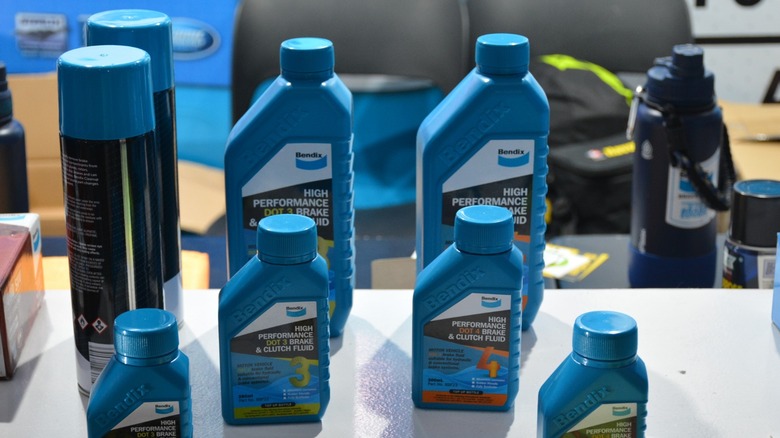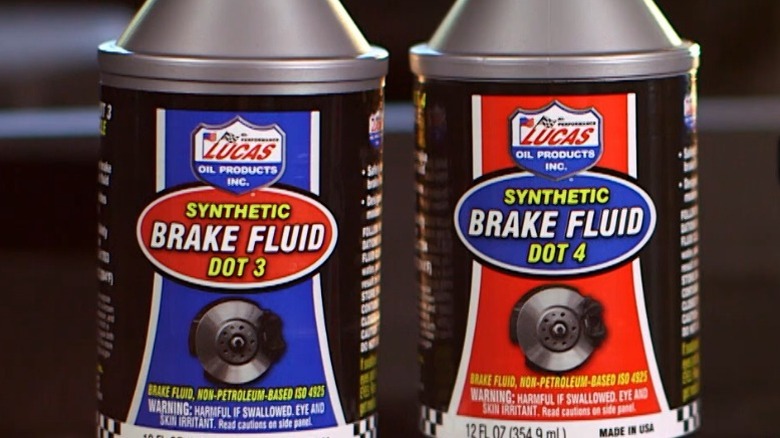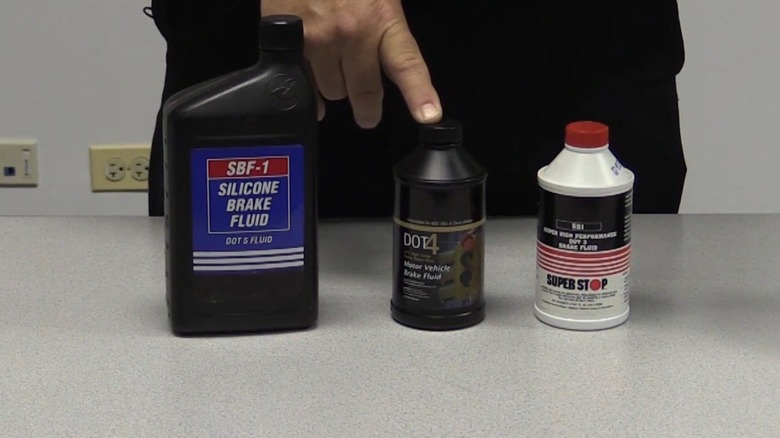DOT 3 Vs. DOT 4 Brake Fluid: Can You Mix Them, And Are They Interchangeable?
Modern cars require a lot of maintenance and individual parts to function properly. Many of those parts degrade over time and require replacement or special attention. Various automotive fluids, in particular, are essential for your vehicle's smooth performance and health. Of those fluids, one of the most vital for your car and your safety is brake fluid.
Brake fluid is a type of hydraulic fluid used in modern automotive brake systems. These systems rely on hydraulic fluid, a master cylinder, a network of fluid lines, and either disc or drum brakes to help stop your car. The master cylinder pressurizes the brake fluid and sends it to the brakes, where the pressurized fluid is used to compress the brake mechanisms. This can be a disc system, a drum system, or a combination of the two, depending on the car. However, not all brake fluid is the same. If you've ever purchased a bottle of brake fluid to perform your own brake job or top off the hydraulic brake fluid in your vehicle, you may have noticed several different types of brake fluid on the shelf at the auto parts store.
Two of the most common variations of brake fluid used in modern passenger cars and trucks are DOT 3 and DOT 4 fluid. While these two fluids are slightly different, they are interchangeable in some situations. You can use DOT 4 if your brake fluid reservoir cap says DOT 3, but you shouldn't put DOT 3 fluid in your car if the cap says DOT 4. Why is that, and what exactly are the differences between these two fluids? That's precisely what we're going to cover now.
What's the difference between DOT 3 and DOT 4 brake fluid?
Before we explain the differences between DOT 3 and DOT 4 brake fluid, it may be helpful to explain what these classifications mean. The first part of the name stands for the Department of Transportation. The DOT is responsible for giving grades or classifications to brake fluid, following the guidelines put forth by the Federal Motor Vehicle Safety Standards (FMVSS). The number following the acronym refers to the fluid's boiling point.
Boiling point is an important factor for hydraulic brake fluid because your car's brakes can get extremely hot during strenuous use, like when driving down a mountainous incline. If the brakes get hot enough, the brake fluid can boil, which creates gas bubbles. Because those gas bubbles can be compressed, your brake pedal can soften if the fluid boils, which leads us into the differences between DOT 3 and DOT 4 fluid.
Of the standard brake fluid variations, DOT 3 fluid has the lowest dry boiling point at 401 degrees Fahrenheit and a wet boiling point of 274 degrees Fahrenheit. The dry boiling point refers to the point at which fresh fluid will boil. After one to two years of use, the fluid's boiling point will drop to what is called a wet boiling point. This means the fluid has absorbed moisture, lowering its boiling point, and necessitating a replacement. In comparison, DOT4 fluid has a dry boiling point of 446 degrees Fahrenheit and a wet boiling point of 311 degrees Fahrenheit. That means that DOT 3 fluid provides slightly less braking power in demanding situations, and you will need to replace it more frequently than DOT 4 fluid.
When are DOT 3 and DOT 4 compatible, and what about other brake fluids?
As mentioned, DOT 3 and DOT 4 brake fluid are interchangeable in some situations. While the best move is to follow your manufacturer's instructions regarding automotive liquids, these two types of hydraulic fluid are compatible with most modern car brake systems. However, because of the difference in boiling point, DOT 3 fluid should not be used in brake systems designed for DOT 4 or a higher-grade fluid. You can put DOT 4 fluid into a DOT 3 system, but you shouldn't put DOT 3 into a DOT 4 system.
That said, DOT 3 and DOT 4 aren't the only kinds of brake fluid that you may encounter. The other two types of brake fluid that you're likely to see are DOT 5 and DOT 5.1 fluid. Like DOT 3 and DOT 4 fluids, DOT 5.1 has a glycol ether base. That makes DOT 5.1 brake fluid compatible with DOT 3 and DOT 4 fluids, but it follows the same rule outlined above — DOT 5.1 fluid can go into a DOT 3 or a DOT 4 system, but you should not put those fluids into a DOT 5.1 system, due to the higher boiling point provided by DOT 5.1 fluid.
The fourth type of brake fluid that you may see on the shelves of some auto parts stores is DOT 5. Unlike the fluids covered above, DOT 5 does not have a glycol ether base. Instead, DOT 5 brake fluid has a silicone base. It is not compatible or interchangeable with any of the other three fluids covered here, and is most frequently used for heavy-duty machinery in very cold climates.


